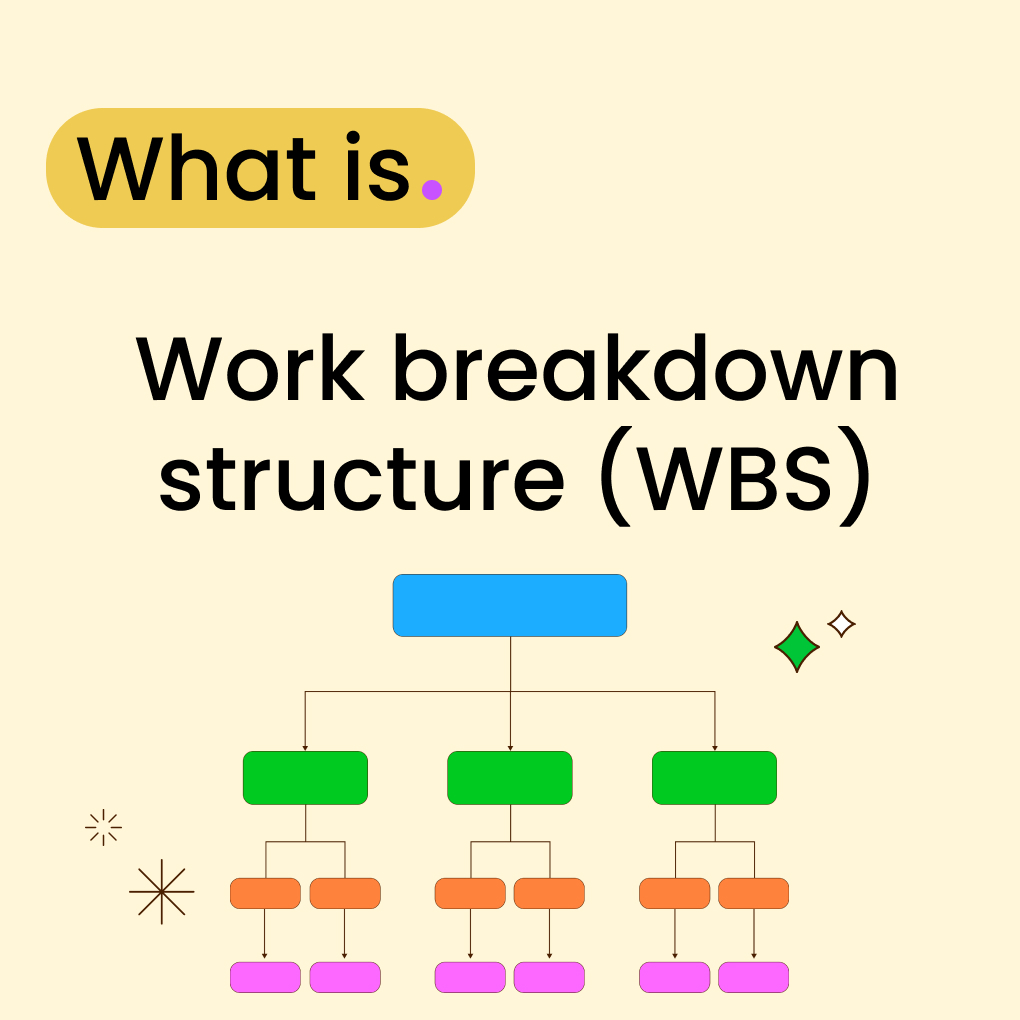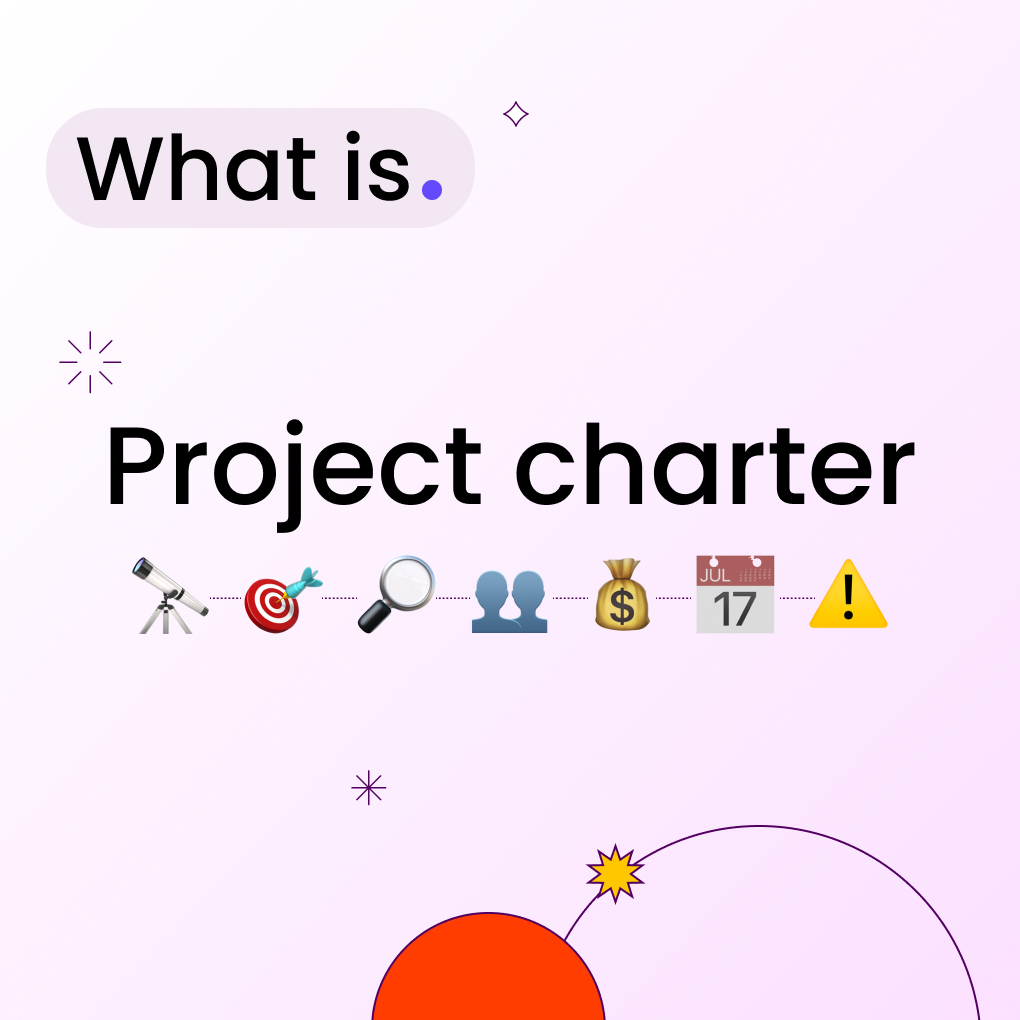What Is a Work Breakdown Structure (WBS)?
In the complex world of project management, clarity and organization are paramount. Whether you’re overseeing the construction of a skyscraper, developing a new software application, or planning a large-scale event, breaking down the monumental task into manageable components is crucial for success. This is precisely where the Work Breakdown Structure (WBS) comes into play. A WBS is a foundational project management tool that provides a hierarchical decomposition of the total scope of work to be carried out by the project team to accomplish the project objectives and create the required deliverables. It visually organizes the project’s scope into smaller, more manageable sections, ensuring that all necessary work is identified and accounted for. Think of it as the blueprint for your project’s execution, detailing what needs to be done, not necessarily how or when. Understanding and effectively utilizing a WBS is fundamental for any project manager aiming for efficient planning, execution, and control.
WBS Meaning and Purpose
To fully grasp the utility of a WBS, it’s essential to understand its core meaning and the purpose it serves within the project lifecycle. It’s more than just a list of tasks; it’s a structured approach to defining and organizing the project scope.
What does WBS stand for?
The acronym WBS stands for Work Breakdown Structure. This term accurately reflects its function: breaking down the total work of a project into a structured hierarchy of components.
What is WBS in project management?
In project management, the WBS is a key deliverable that organizes the team’s work into manageable sections. It’s a hierarchical decomposition of the project scope, breaking down deliverables and objectives into smaller, more easily handled components called work packages. The WBS project management definition emphasizes its role in defining scope, facilitating planning, and enabling control. It serves as a primary input for planning processes like cost estimation, resource allocation, risk assessment, and schedule development. Without a clear WBS, projects risk scope creep, missed deadlines, and budget overruns because the full extent of the work hasn’t been properly defined and visualized.
Why is WBS important in planning and execution?
The WBS is critically important for several reasons:
- Scope Definition: It provides a clear and comprehensive definition of the project’s scope, ensuring everyone understands what is included (and implicitly, what is not).
- Foundation for Planning: It forms the basis for all subsequent planning activities. Estimates for time, cost, and resources are often derived directly from the WBS components. Schedules are built by sequencing WBS elements.
- Improved Communication: It offers a visual representation of the project scope, facilitating clear communication among stakeholders, team members, and clients. Everyone can see how their work contributes to the overall project goals.
- Enhanced Control & Monitoring: By breaking the project into smaller pieces, the WBS allows for more accurate tracking of progress, cost, and performance at various levels. It helps identify potential issues early on.
- Accountability: It clarifies responsibilities by linking specific work packages to individuals or teams.
- Risk Management: Decomposing the work helps in identifying risks associated with specific components more effectively.
Essentially, the WBS acts as the project’s backbone, providing structure and clarity from initiation through closure.
Benefits of using a WBS
Utilizing a Work Breakdown Structure offers numerous tangible benefits:
- Prevents Scope Creep: Clearly defines boundaries, making it harder for unapproved changes to slip in.
- Accurate Estimations: Breaking work down allows for more precise time and cost estimates for individual components, which roll up to a more reliable overall estimate.
- Resource Optimization: Helps in identifying resource needs for specific tasks, leading to better allocation.
- Clear Task Assignments: Simplifies assigning responsibility for specific deliverables or work packages.
- Improved Stakeholder Confidence: A well-defined WBS demonstrates thorough planning and control.
- Basis for Performance Measurement: Establishes a baseline against which project performance can be measured (e.g., Earned Value Management).
- Reduces Ambiguity: Minimizes confusion about what needs to be accomplished.
Components of a Work Breakdown Structure
A well-constructed WBS has distinct components and follows a specific hierarchical logic. Understanding these elements is key to creating an effective structure.
Main elements of WBS
The core components typically found in a WBS include:
- Levels: The hierarchical layers of the WBS, starting from the overall project at the top (Level 1) down to the detailed work packages at the lowest level.
- Deliverables: Tangible, verifiable outcomes or results that must be produced to complete the project or a part of the project. These often form the basis for the decomposition at higher levels.
- Work Packages: The lowest level of the WBS. These represent the smallest unit of work that can be realistically estimated, scheduled, assigned, and controlled. A work package should define a specific task or set of tasks that result in a verifiable outcome.
- Control Accounts (Optional but common): Management control points where scope, budget, actual cost, and schedule are integrated and compared to earned value for performance measurement. A control account may include one or more work packages.
- WBS Dictionary: A companion document providing detailed information about each component in the WBS.
Levels of a WBS structure
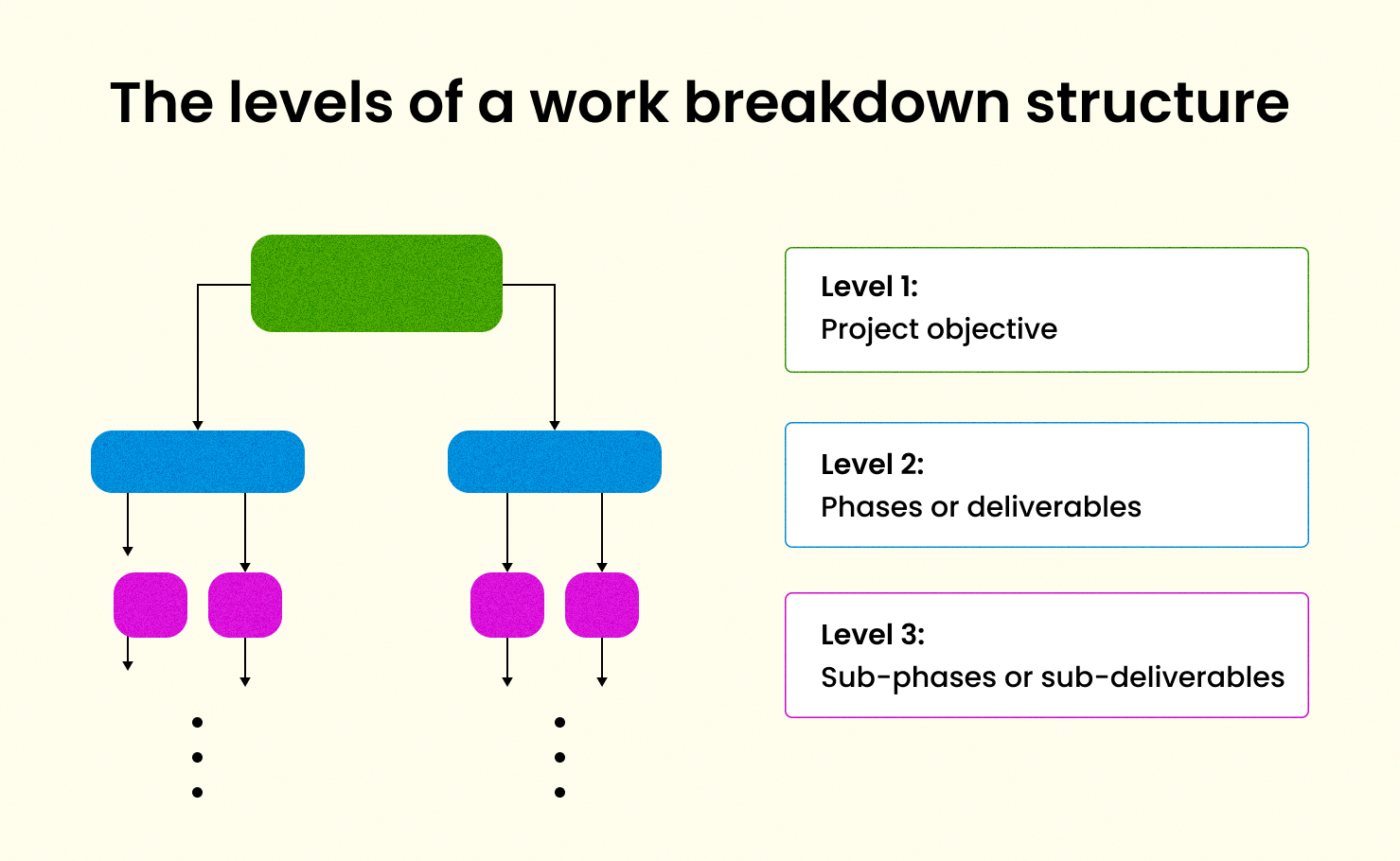
The WBS structure is inherently hierarchical.
- Level 1: Represents the entire project (e.g., “New House Construction”). This is the root of the structure.
- Level 2: Major deliverables or project phases (e.g., “Foundation,” “Framing,” “Exterior,” “Interior Systems”). These are the primary subdivisions of the project scope.
- Level 3: Further decomposition of Level 2 elements into more detailed components or sub-deliverables (e.g., under “Foundation,” you might have “Excavation,” “Footings,” “Foundation Walls”).
- Lower Levels (Level 4, 5, etc.): Continued breakdown until reaching the Work Package level. The depth depends on the project’s complexity and the level of control needed. A work package is the lowest level and represents a discrete piece of work that can be assigned, estimated, and tracked (e.g., under “Excavation,” a work package might be “Clear and Grub Site”).
The key is that the sum of the work at any lower level must equal the total work represented by its parent element at the level above (the 100% Rule).
What does WBS include?
A comprehensive WBS should include 100% of the work defined by the project scope. This means it covers all deliverables – internal, external, and interim – as well as project management activities required to complete the project. It focuses on the what (deliverables and outcomes) rather than the how (specific activities or methods, which belong in the schedule). It typically includes nouns (representing deliverables or components) rather than verbs (representing actions). For example, “Foundation Walls” (deliverable) is preferred over “Pour Foundation Walls” (activity).
What is a WBS dictionary and what’s in it?
The WBS Dictionary is a crucial companion document that provides detailed descriptions of the components listed in the WBS hierarchy. While the WBS itself shows the breakdown of work, the dictionary elaborates on each element. For each WBS component, especially the work packages, the dictionary typically includes:
- WBS Code/Identifier: A unique code linking the dictionary entry to the WBS element.
- Description of Work: A detailed narrative explaining the tasks involved in the component or work package.
- Assigned Responsibility: The individual, department, or organization responsible for completing the work.
- Schedule Milestones: Key dates or deadlines associated with the component.
- Required Resources: Personnel, equipment, or materials needed.
- Cost Estimates: Budget allocated to the component.
- Quality Requirements: Standards or criteria the deliverable must meet.
- Acceptance Criteria: Conditions that must be satisfied for the component to be considered complete.
- Contract Information (if applicable): Relevant contractual details.
The WBS dictionary adds essential context and detail, preventing ambiguity and ensuring everyone understands the scope and requirements of each work package.
Types of Work Breakdown Structures
While the hierarchical principle remains constant, WBS can be structured based on different organizing principles, primarily focusing on deliverables or phases.
Deliverable-based WBS
This is the most common and often recommended approach. It organizes the WBS around the tangible products, results, or capabilities the project is set to deliver.
- Focus: The what of the project – the physical components, software features, or service outcomes.
- Structure: Level 1 is the overall project. Level 2 lists the major deliverables. Subsequent levels break these deliverables down into smaller sub-deliverables and components until the work package level is reached.
- Example: For building a website, Level 2 might include “Homepage Design,” “Product Pages,” “Checkout Process,” “Content Creation.”
- Advantage: Directly aligns with the project’s objectives and makes it easy to track the completion of tangible outputs.
Phase-based WBS
This approach organizes the WBS around the project lifecycle phases or major stages of work.
- Focus: The timing or process of the project.
- Structure: Level 1 is the overall project. Level 2 lists the major project phases (e.g., “Planning,” “Design,” “Development,” “Testing,” “Deployment”). Each deliverable is then placed under the relevant phase where it is primarily created.
- Example: For software development, Level 2 might be “Requirements Gathering,” “Design,” “Coding,” “Testing,” “Release.” The deliverable “User Manual” might fall under the “Testing” or “Release” phase.
- Advantage: Useful when the project timeline and process flow are the primary drivers, or when funding is allocated phase by phase.
- Disadvantage: Can sometimes obscure the final deliverables if they span multiple phases. Often, a hybrid approach is used where major deliverables are identified within phases.
Functional vs. project-based structures
This distinction relates more to how the overall organization influences the WBS rather than the WBS type itself.
- Functional WBS: In strongly functional organizations, the WBS might be structured around departments or functional units (e.g., “Engineering Dept Work,” “Marketing Dept Work,” “Manufacturing Dept Work”). This is less common for true project WBS as it focuses on organizational structure rather than project deliverables.
- Project-Based WBS: Focuses entirely on the project’s deliverables or phases, irrespective of the organizational structure performing the work. This is the standard approach for effective project management using WBS.
WBS vs. workflow breakdown vs. process breakdown
These terms are sometimes confused, but they represent different concepts:
- Work Breakdown Structure (WBS): Focuses on decomposing the deliverables or scope of the project into hierarchical components (the what). It’s product-oriented.
- Workflow Breakdown: Focuses on the sequence of activities or steps required to complete a specific process or task (the how). It’s activity-oriented and often represented in flowcharts. Example: The steps to approve an invoice.
- Process Breakdown: Similar to workflow, it decomposes a business process into its constituent activities and decisions, often for analysis or improvement purposes. Example: Breaking down the entire “Order Fulfillment” process.
While related (WBS defines what needs doing, workflow/process defines how it gets done), they serve different purposes. The WBS is about scope definition for planning, while workflow/process breakdowns are about operational execution and efficiency.
Work Breakdown Structure Examples
Seeing examples makes the concept of WBS much clearer. They can be represented in various formats.
Tabular WBS example
A tabular or outline format is simple and easy to create, especially in spreadsheets or documents.
Project: Simple Website Development
1.0 Website Development
├── 1.1 Planning & Design
│ ├── 1.1.1 Requirements
│ ├── 1.1.2 Wireframes
│ └── 1.1.3 Mockups
├── 1.2 Content Creation
│ ├── 1.2.1 Copy
│ └── 1.2.2 Images
├── 1.3 Development
│ ├── 1.3.1 Frontend
│ │ ├── 1.3.1.1 Homepage
│ │ └── 1.3.1.2 Product Page
│ └── 1.3.2 Backend
└── 1.4 Testing & Deployment
├── 1.4.1 Testing
└── 1.4.2 Deployment
This WBS example tabular view clearly shows the hierarchy through indentation and numbering.
Hierarchical/tree structure example
A tree structure provides a more visual representation of the hierarchy, often used in presentations or specialized software.
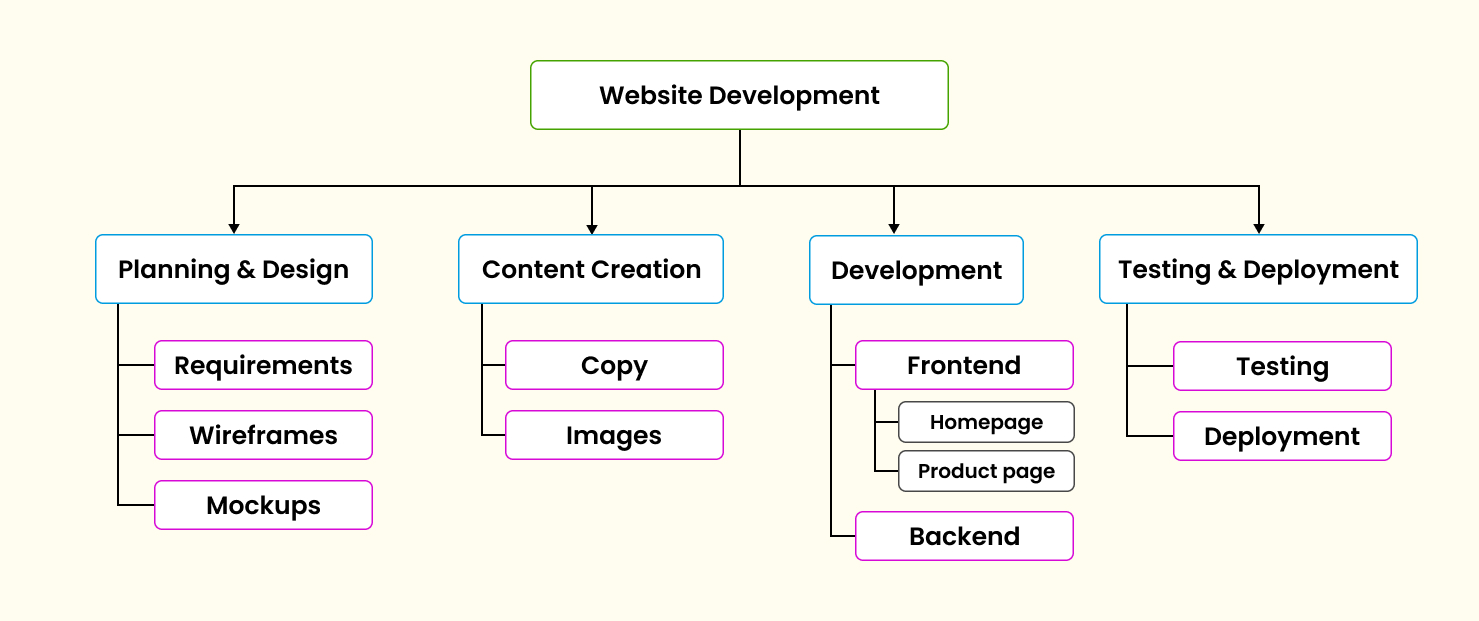
This visual format makes the parent-child relationships immediately apparent.
Real-world WBS examples by industry
The structure adapts to the specific industry and project type.
Building Construction Work Breakdown Structure Example (Deliverable-Based)
- Level 1: New Office Building Construction
- Level 2: Site Preparation
- Level 3: Demolition
- Level 3: Grading & Excavation
- Level 2: Foundation
- Level 3: Footings
- Level 3: Foundation Walls
- Level 3: Slab on Grade
- Level 2: Superstructure
- Level 3: Structural Steel Framing
- Level 3: Floor Decking
- Level 3: Roof Structure
- Level 2: Building Envelope
- Level 3: Exterior Walls & Cladding
- Level 3: Roofing System
- Level 3: Windows & Doors
- Level 2: Interior Construction
- Level 3: Interior Partitions
- Level 3: Ceilings
- Level 3: Floor Finishes
- Level 2: MEP Systems (Mechanical, Electrical, Plumbing)
- Level 3: HVAC System
- Level 3: Electrical Distribution
- Level 3: Plumbing System
- Level 2: Project Management & Administration (often included as a major element)
This WBS for construction project focuses clearly on the physical components being built.
Software Development (Phase-Based Example):
- Level 1: New CRM Software
- Phase 1: Requirements Analysis
- Level 3: User Interviews
- Level 3: Requirements Document
- Phase 2: System Design
- Level 3: Architecture Design
- Level 3: UI/UX Design
- Level 3: Database Design
- Phase 3: Implementation
- Level 3: Module A Development
- Level 3: Module B Development
- Level 3: Integration
- Phase 4: Testing
- Level 3: Unit Testing
- Level 3: System Testing
- Level 3: User Acceptance Testing
- Phase 5: Deployment
- Level 3: Production Setup
- Level 3: Data Migration
- Level 3: Go-Live
What makes a good WBS example?
A good work breakdown structure exhibits several key characteristics:
- Follows the 100% Rule: Includes all project work and only project work. The sum of child elements equals the parent element.
- Mutually Exclusive Elements: No overlap in scope between different elements at the same level. Avoids duplication of work and confusion.
- Deliverable-Oriented (Generally Preferred): Focuses on outcomes rather than actions.
- Appropriate Level of Detail: Decomposed sufficiently to allow for accurate estimating, assignment, and control (reaching the work package level), but not so detailed that it becomes an unmanageable task list (micromanagement). The “8/80 Rule” is sometimes cited (work packages should take between 8 and 80 hours), but this is just a guideline.
- Clear Naming Convention: Uses nouns and descriptive titles for elements.
- Includes WBS Dictionary: Provides necessary detail for each element.
- Created Collaboratively: Developed with input from the project team members who will perform the work.
How to Create a Work Breakdown Structure
Creating a robust WBS involves a systematic process, typically involving the project manager and key team members. Here’s how to make a work breakdown structure (WBS):
Step 1 – Define the project scope and objectives
Before breaking down the work, you must clearly understand what the project aims to achieve. Gather key project documents:
- Project Charter
- Scope Statement
- Requirements Documentation
Ensure objectives are SMART (Specific, Measurable, Achievable, Relevant, Time-bound). This provides the foundation for Level 1 of the WBS.
Step 2 – Identify major deliverables
Based on the scope and objectives, identify the main outputs or results the project needs to produce. These could be physical products, software components, key documents, or significant service outcomes. These major deliverables will typically form Level 2 of your WBS if using a deliverable-based approach, or they will be identified within phases if using a phase-based approach.
Step 3 – Break deliverables into work packages
This is the core decomposition process. Take each major deliverable (or phase) from Level 2 and break it down into smaller, more manageable components (Level 3). Continue decomposing these components (Level 4, etc.) until you reach the work package level. A work package should be small enough to be:
- Assigned to a specific person or team.
- Estimated accurately in terms of time and cost.
- Tracked effectively for progress.
- Result in a verifiable outcome.
Use brainstorming sessions, expert judgment, and review of similar past projects. Ensure the 100% rule is applied at each level.
Step 4 – Assign owners and responsibilities
While the WBS itself focuses on what, assigning ownership is a critical related step, often documented in the WBS Dictionary or a separate responsibility assignment matrix (RAM). Assign responsibility for each work package to ensure accountability.
Step 5 – Allocate resources and costs
The WBS provides the framework for WBS allocation. Estimate the resources (people, equipment, materials) and costs required for each work package. These estimates can then be rolled up the hierarchy to determine the budget for higher-level components and the overall project. This forms the basis for budget control.
Step 6 – Set timelines and dependencies
Although the WBS isn’t the schedule itself, it’s the primary input. Once work packages are defined, you can estimate their duration, identify dependencies between them (e.g., Work Package B cannot start until Work Package A is finished), and build the project schedule using techniques like Gantt charts or network diagrams.
Step 7 – Validate and finalize the WBS
Review the completed WBS and its dictionary with key stakeholders and the project team. Ensure:
- It accurately reflects the entire project scope (100% Rule).
- Elements are clearly defined and mutually exclusive.
- The level of detail is appropriate.
- It aligns with project objectives.
Obtain formal approval or consensus before using it as the baseline for further planning and execution.
Requirements Before and After Creating a WBS
The WBS doesn’t exist in isolation; it’s tightly integrated with other project management processes, particularly requirements definition and scheduling.
What should be done before creating a WBS?
Before you start decomposing work, you need a solid understanding of the project’s foundation:
- Define Project Objectives: Clearly articulate what the project aims to achieve.
- Gather High-Level Requirements: Understand the key needs and expectations of stakeholders. What must the final product or service do?
- Develop a Project Charter: Formal authorization for the project, outlining objectives, scope, and stakeholders.
- Create a Preliminary Scope Statement: An initial description of the project’s deliverables and boundaries.
Essentially, you need to know why you’re doing the project and what the major outcomes should be before you can effectively break down how you’ll get there in terms of work components.
Aligning WBS with project requirements
There’s a close relationship between requirements and the WBS. Should requirements come before or after work breakdown structure creation? Generally, high-level requirements gathering comes before WBS development to define the overall scope. However, the detailed decomposition process during WBS creation often helps refine and clarify requirements. As you break down deliverables, you might uncover more specific requirements associated with lower-level components.
The WBS should directly trace back to the project requirements. Each requirement should map to one or more WBS elements, ensuring that all requirements are addressed within the project scope defined by the WBS. This traceability is crucial for scope validation and change control.
What comes after the WBS is completed?
Once the WBS and its dictionary are finalized and approved, they become the foundation for numerous subsequent planning activities:
- Activity Definition: Defining the specific schedule activities required to produce the work packages.
- Sequencing Activities: Identifying dependencies and ordering the activities.
- Estimating Resources: Determining the type and quantity of resources needed for each activity.
- Estimating Durations: Estimating the time required to complete each activity.
- Developing the Schedule: Creating the project timeline (e.g., Gantt chart).
- Cost Estimating: Developing cost estimates for activities and work packages.
- Determining the Budget: Aggregating costs to establish a cost baseline.
- Quality Planning: Identifying quality standards relevant to WBS elements.
- Risk Identification: Analyzing WBS elements to identify potential risks.
- Procurement Planning: Identifying elements that need to be procured externally.
- Communications Planning: Defining how WBS information will be communicated.
The WBS serves as the central organizing structure linking scope to schedule, cost, risk, and resource planning.
Integrating WBS into project scheduling tools
Most project management software (like Microsoft Project, Jira with specific configurations, or dedicated WBS tools) allows you to directly input or import your WBS structure. The WBS codes often serve as identifiers linking tasks in the schedule back to the defined scope components. This integration allows for:
- Visualizing the schedule against the WBS hierarchy.
- Rolling up progress and cost data from tasks to work packages and higher WBS levels.
- Facilitating Earned Value Management (EVM) by comparing planned value, earned value, and actual cost at control account or work package levels defined in the WBS.
- Ensuring the schedule remains aligned with the approved project scope.
Work Breakdown Structure Best Practices
Creating an effective WBS requires adherence to certain principles and awareness of common pitfalls.
Characteristics of an effective WBS
A good work breakdown structure is:
- Deliverable-Oriented: Focuses on outcomes.
- Hierarchical: Clearly shows levels of decomposition.
- Comprehensive (100% Rule): Covers all scope, no more, no less.
- Mutually Exclusive: No overlap between elements at the same level.
- Appropriately Detailed: Decomposed to the work package level suitable for management.
- Clear and Unambiguous: Element names and dictionary descriptions are easily understood.
- Flexible: Can accommodate controlled changes through a formal change management process.
- Integrated: Serves as the foundation for other planning processes.
- Visual: Presented in a format (tree, outline) that is easy to understand.
Common mistakes to avoid
- Too Much Detail (Micromanagement): Breaking down work packages into individual, minute activities within the WBS itself. The WBS defines deliverables/components; the schedule defines activities.
- Too Little Detail: Stopping the decomposition too early, leaving large, vague components that are difficult to estimate or manage.
- Using Verbs Instead of Nouns: Focusing on actions rather than deliverables (e.g., “Write Code” instead of “User Login Module”).
- Not Following the 100% Rule: Including work outside the scope or omitting necessary work.
- Inconsistent Level of Detail: Having some branches decomposed much further than others without justification.
- Creating it in Isolation: Not involving the team members who understand the work.
- Treating it as the Schedule: Confusing the breakdown of work with the sequence and timing of tasks.
- Not Creating a WBS Dictionary: Leaving room for ambiguity about what each element entails.
How detailed should a WBS be?
There’s no single answer, as it depends on project size, complexity, risk, and the level of control required. Key considerations include:
- Estimating Accuracy: Can you confidently estimate the cost and duration of the work package?
- Assignment: Can the work package be assigned to a specific individual or team?
- Measurability: Can you objectively determine when the work package is complete?
- Manageability: Is the duration short enough for effective monitoring (often suggested guidelines like 8-80 hours or within a single reporting period)?
- Risk: Higher-risk components may warrant more detailed breakdown.
The goal is sufficient detail for planning and control, without excessive granularity that becomes burdensome.
Making WBS scalable and reusable
- Scalability: Use a clear numbering system and structure that can accommodate additions or changes if the scope evolves (through formal change control). Modular design helps.
- Reusability: For organizations undertaking similar projects, WBS templates can be developed. A template for “Residential House Construction” could be adapted for different specific house projects, saving time and ensuring consistency. Standardizing Level 2 or 3 elements for common project types promotes reuse.
How to use Morningmate as your work breakdown structure tool
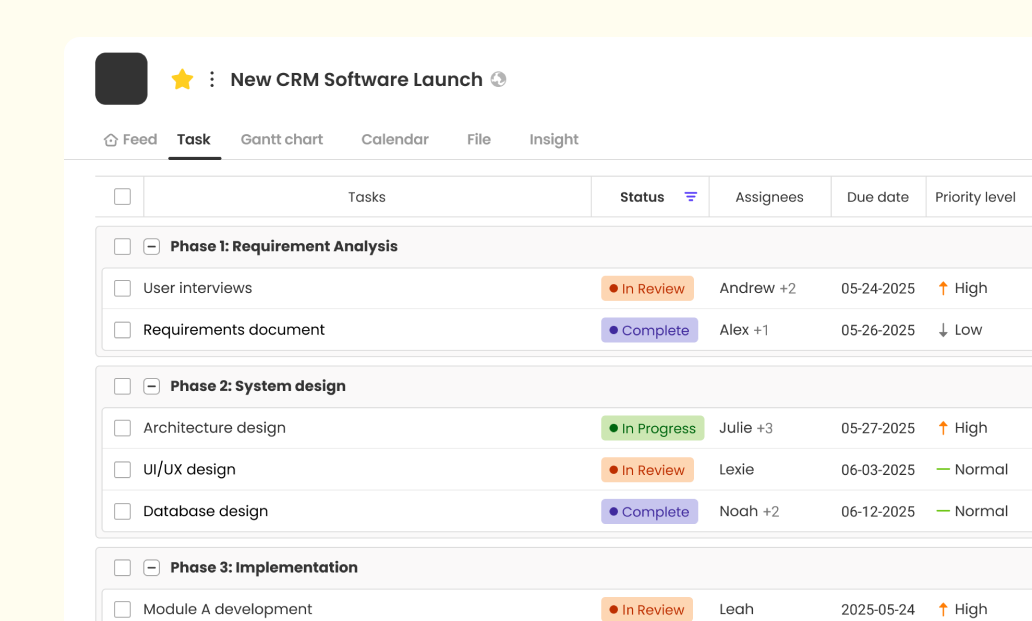
While traditional tools like spreadsheets or generic project software can be used, dedicated platforms often streamline WBS creation and integration. A tool like Morningmate, designed for team productivity and project coordination, can significantly enhance how you build and utilize your WBS.
Imagine using Morningmate to:
- Visually Build Your WBS: Utilize interactive features (like mind maps or hierarchical lists) to collaboratively brainstorm and structure your project’s deliverables and work packages visually.
- Link WBS Elements to Tasks: Seamlessly connect WBS components directly to actionable tasks within Morningmate’s task management system. This ensures the schedule directly reflects the defined scope.
- Create Your WBS Dictionary: Attach notes, files, deadlines, and responsible team members directly to each WBS element within Morningmate, effectively creating a dynamic WBS dictionary.
- Facilitate Collaboration: Allow team members to view the WBS, understand their assigned work packages, and provide input directly within the shared workspace.
- Track Progress Against WBS: As tasks linked to work packages are completed in Morningmate, progress can automatically roll up, providing a clear view of completion status against the WBS structure.
- Integrate with Other Planning: Use the WBS defined in Morningmate as the basis for resource allocation, timeline visualization, and potentially cost tracking features within the platform.
- Maintain Templates: Save your finalized WBS structures as templates within Morningmate for quick reuse on future, similar projects.
By leveraging a collaborative platform like Morningmate, the WBS transitions from a static planning document into a dynamic, integrated part of your daily project execution and monitoring, helping teams stay aligned and focused on delivering the defined scope efficiently.
Mastering the Work Breakdown Structure is a fundamental step towards more predictable and successful project outcomes. By clearly defining what needs to be done through hierarchical decomposition, project managers lay the groundwork for accurate planning, effective communication, and robust control throughout the project lifecycle. Whether you’re tackling a complex building construction project or any other endeavor, a well-crafted WBS is an indispensable tool in your project management arsenal.

